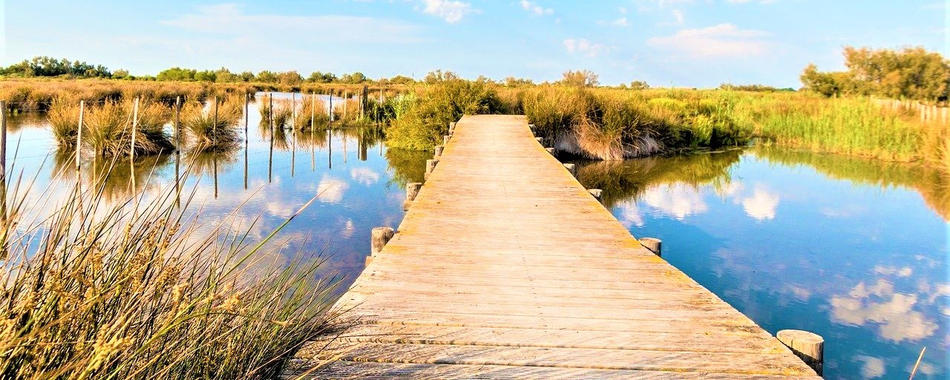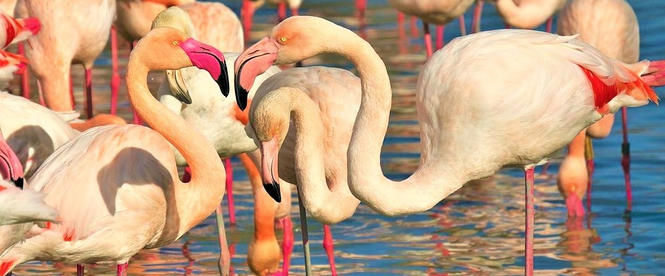What to do in Camargue ?

What to do in Camargue ? This part of southern France, a wild and unspoilt region, stands as the largest wetland area in the country in terms of surface area, covering nearly 150,000 hectares. This expansive territory stretches over 80 km of sandy coastline along the Mediterranean shores.
What to see and visit in the Camargue ? There's so much to discover in this beautiful region of southern France, it's hard to sum it all up in a single sentence... I hope this article gives you a good overview.
Visit Camargue, unique flora and fauna in the heart of an exceptional natural site
Stroll among pink flamingos, bulls and other Camargue horses
The Camargue is distinguished by exceptional biodiversity composed of numerous animal and plant species. Regarding the fauna, the famous herds of bulls and the majestic Camargue horses with their white color mingle in its vast expanses, symbolizing the wild and untamed identity of this region. The pink flamingos, undisputed emblems, populate the salt flats and lagoons, adding touches of pink to the environment.
Enthusiasts of ornithology can also observe, in parks and nature reserves such as those of Scamandre and Pont de Gau, grey herons, little egrets, and many other species of migratory birds, such as white storks and black storks. Raptors also play a role in this ecosystem, such as eagles majestically soaring through the sky. Furthermore, these wetlands also harbor a multitude of species of fish, amphibians, and reptiles.

Discover the sansouire and soak up the scents of the wild flora
On the side of flora, the Camargue is as diverse as the landscape that characterizes it. This vast wetland harbors an impressive variety of plants adapted to changing environmental conditions, primarily found in the salt marshes. These are flat natural expanses with a high concentration of salt located near the seashore, where many halophyte species thrive, including glasswort and sea lavender. Sea lavender is an emblematic plant of the Camargue landscape, recognizable by its small purplish flowers. Moreover, it is considered the lucky flower of the "gardians" (Camargue cowboys). Glasswort, on the other hand, is an edible plant abundant in the salt marshes of the Camargue.
Other plant species make up this unique flora, including vast expanses of reed beds that provide a vital habitat for numerous species. Helichrysum, an emblematic plant with yellow or blue flowers, can also be found along the shores of the Mediterranean Sea.

Rice paddies, ponds and vineyards, admire extraordinary landscapes
The natural landscapes of the Camargue reveal a harmony between water, land, and sky. The vast salt marshes with their rosy reflections lend the region a mystical atmosphere. Meanwhile, rice fields and meadows blend seamlessly with the numerous vineyards planted in sandy locations. These are truly extraordinary landscapes that are offered to you in the Camargue.
In addition, the beaches of the Camargue add a coastal dimension to the diversity of the region's natural landscapes. The renowned Plage de l'Espiguette, with its endless sandy dunes dotted with lush green pines, offers a pristine Mediterranean landscape. The less crowded but equally picturesque Plage de Beauduc captivates with its stretches of fine sand and shallow waters, creating an ideal spot for relaxation and swimming.
The Camargue stands out for its fascinating fauna and flora, as well as its spectacular landscapes, representing a natural paradise where wildlife thrives within a unique environment.

What villages and monuments to see in Camargue, discover a heritage steeped in history
Wander through the alleys of picturesque villages
Aigues-Mortes, Les Saintes-Maries-de-la-Mer, and Arles are typical villages and towns in the Camargue, each with its own distinct characteristics.
Aigues-Mortes and its ramparts
Aigues-Mortes is a city located in the department of Gard, in the Occitanie region. Founded in the 13th century by King Louis IX, also known as Saint-Louis, Aigues-Mortes was a flourishing and strategic port in the Middle Ages. Today, the city is renowned for its exceptionally well-preserved medieval heritage, notably its imposing city walls. This fortified enclosure was established to protect the city and especially its port from maritime invasions in the 13th century. The defense system includes fortified gates, crenellated walls, and towers, among which the famous Tour de Constance stands out. This tower served as a prison and also as a royal residence in different periods. Its architecture and strategic location make it a powerful symbol of royal power in the medieval era. From the city walls, a panoramic view of the old town of Aigues-Mortes and the Camargue unfolds before you.
Saintes-Maries-de-la-Mer and its church
Saintes-Maries-de-la-Mer is a commune located in the department of Bouches-du-Rhône, in the Provence-Alpes-Côte d'Azur region. This coastal village is famous for its church dedicated to the Saintes-Maries, traditionally associated with Mary Salome, Mary Jacobé, and Mary Magdalene, venerated as the patron saints of the Gypsies. Therefore, it is nowadays an important pilgrimage site for Christians and Gypsies alike. The church is believed to have ancient origins dating back to the 9th century and has been classified as a historical monument since 1840. This town is also known for its beaches, houses with white facades, and authentic Camargue traditions.
Arles and its Roman monuments
Arles is also a city located in the Bouches-du-Rhône department, in the Provence-Alpes-Côte d'Azur region. The relationship between Arles and the Camargue is close, as it serves as a gateway to the Camargue for visitors. The city not only provides access to this territory but is also rich in history, Roman architecture, and artistic culture. Roman remnants such as the Roman amphitheater and the Romanesque Saint-Trophime church make Arles an important cultural destination.

Towers in the Camargue, magicals viewpoints between dunes and rice fields
The Tour Carbonnière
Located in Saint-Laurent-d'Aigouze, it was built at the end of the 13th century during the reign of King Philip VI of Valois, the successor to Saint-Louis. This tower was erected to protect and control access by land and water leading to Aigues-Mortes and the port of Le Grau-du-Roi. The tower gets its name from the Carbonnière family, the owners of the land on which it was built.
The Espiguette lighthouse
This lighthouse is located on Plage de l'Espiguette and is part of the municipality of Le Grau-du-Roi. It is another significant monument in the Camargue. First commissioned in 1869, it has a 27-meter-high square tower that is predominantly painted white. Now automated, the lighthouse is open to the public and offers a breathtaking view of the beach, the sea, and the surrounding area.

Camargue culture, a blend of culinary specialties and rich traditions
The culinary Camargue specialities : a gourmet journey not to be missed
One of the must-do experiences to answer the question ‘What to do in the Camargue’ is to discover the local specialities, a true voyage of the senses.
Here, gastronomy is intimately linked to the landscape: imagine immense rice fields undulating under the sun, producing the famous Camargue rice, the indispensable companion of gardianne de taureau, a savoury stew simmered in spicy red wine.
On the seaside, the Camargue bouillabaisse invites you to sample an explosion of marine flavours, combining fresh fish, shellfish and Mediterranean crustaceans.
Don't miss the fougasse camarguaise, a soft bread flavoured with orange blossom when sweet, or with a touch of salt from the Aigues-Mortes salt marshes when savoury.
To accompany these delights, let yourself be surprised by the vins des sables, produced on vines rooted in the dunes, offering light, fruity rosés perfect for an aperitif under the Camargue sun.
An authentic feast awaits you in the heart of this wild and generous land!
For the more curious gourmets, don't miss our article devoted to the culinary specialities not to be missed around Montpellier.

Attend Traditional Festivals Perpetuated Over Time
Bullfighting Traditions and votive celebrations
The Camargue is rich in traditions, particularly bullfighting Traditions such as abrivado and bandido. These events involve the movement of bulls through the streets of villages, accompanied by horse-mounted guardians. The Abrivado moves toward the arenas, while the Bandido brings the bulls back to the pastures. The gardians are the guardians of the bull herds in the region. Their distinctive attire, including striped shirts, tight pants, and felt hats, is an important part of Camargue tradition.
Regarding the votive celebrations that take place every summer in honor of the patron saints. These celebrations include processions, Camargue races, traditional dances, and other festivities.
Pilgrimage to Saintes-Maries-de-la-Mer
Religious traditions are also deeply rooted in the Camargue, especially in Les Saintes-Maries-de-la-Mer, where every May 25th, a big pilgrimage and a large religious and Gypsy festival in honor of Saint Sarah take place, attracting pilgrims and visitors from across the region.
Camargue cross
How could we not mention the famous cross of Camargue, which is an iconic symbol of the Camargue region, representing faith, hope, and charity.
Aigues-Mortes salt marshes
Finally, the exploitation of salt in the Aigues-Mortes salt marshes is a traditional process that has been preserved over the centuries. Salt workers, often dressed in white to protect themselves from the intense sun, harvest salt using shovels and rakes. This traditional activity is not only an important element of the local economy but also an integral part of the cultural identity of the region.

Lisa Pagès









